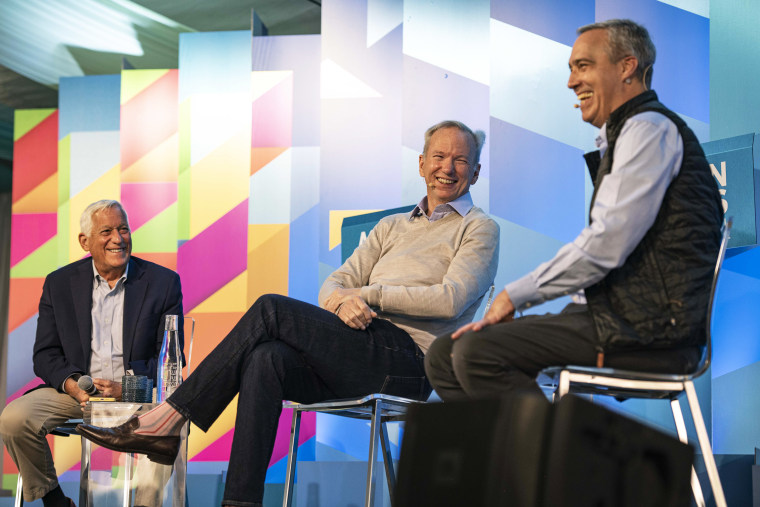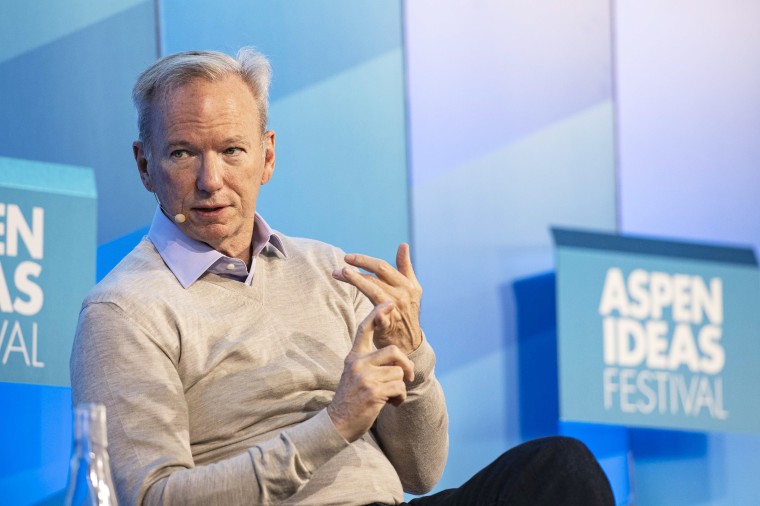‘Migration and the Meaning of Home’ panel also comes to an end
After a few questions from attendees, the conversation between Bush Hager, Zamora and Ford wrapped up with one final note from Zamora.
“Remember your ancestors,” he said. “You’re making them proud.”
Second AI panel ends with focus on educating children
The panel comes to an end with a focus on education and what age makes sense for children to be able to use tech like ChatGPT.
Roy noted that chatbots can allow for a certain amount of filtering, meaning they could be safe for kids to use — or at least as safe or safer than surfing the open internet.
Saha said that concerns about tech changing how children learn goes back a ways — including to his own upbringing, when his parents warned him not to lean to heavily on calculators.
Ford shares why he was critical of Titan sub coverage
The author was asked to elaborate on one of his tweets from earlier this week, in which he juxtaposed images of the Titan submersible to a capsized boat carrying migrants off the coast of Greece.
A fishing boat crowded with migrants traveling from Libya to Italy sank in Greek waters a week before the Titan submersible news broke. However, as NBC News reported, it garnered far less attention than the Titan rescue efforts.
“That was upsetting,” Ford said, suggesting that perhaps the fascination with the Titan sub stemmed from “the very horrific way that we envisioned them perishing.”
“But these other people also perished equally (as) horrifically,” He said of the migrants, “and in a greater scale, and that’s just that day.”
”Five deaths is tragic, 500 deaths is a statistic,” he said. “And that’s heartbreaking.”
Is AI going to further entrench Big Tech?
Roy warned that this could be due to the costs associated with training AI models. But Saha noted that there’s a lot of startups that have their own models.
It’s also worth noting there is a big open source AI movement that some experts think is outpacing even some of the tech behemoths.
AI doesn’t necessarily mean a loss of jobs, Saha says
Saha said that questions about businesses, AI and jobs is important, but that it doesn’t necessarily mean a loss of jobs.
He pointed to AI used in Amazon fulfillment centers that have meant the company can service more customers, which in turn led to a need for more people.
Roy noted that there has long been a push and pull between technology and humans when it comes to labor, and that the rapid rise of AI is what makes this era unique.
“I think that it’s not the first time we have a powerful technology that is clearly going to play some significant part of what people spend their time doing,” he said. “The speed at which it has arrived is new.”
Jamie Ford wanted to debunk stereotypes with his book
Ford, whose great-grandfather emigrated from China to Nevada to mine, said he wanted to debunk stereotypes with his book “The Many Daughters of Afong Moy.”
The novel, a 2022 Read With Jenna pick, follows 250 years down the family tree of Afong Moy, a real-life historical figure thought to be the first Chinese woman in the United States in the 1830s.
“I was always fascinated with this woman’s journey, especially because there’s all this about her and people looked at her like this intrepid world traveler,” Ford told Hager. “They looked at her like this cultural ambassador, but a Chinese woman couldn’t leave China. The punishment was death if they returned. So in all likelihood she was sold into this life, and I wanted to give her a voice.”
Amazon has a lot of businesses using its AI technology
Saha said that Amazon currently has more than 100,000 businesses using its AI and machine learning technology.
It’s a stat that highlights how many different AI applications there are far beyond the kind of generative AI that has captured the public’s imagination recently.
Author Javier Zamora reflects on ‘Solito’
When talking about his memoir “Solito,” Zamora said he saw someone holding a sign during the WGA strike that read, “AI doesn’t have a traumatic childhood.”
“It’s true,” he said.
The memoir follows his nine-week migration from El Salvador to the United States when he was 9 years old.
“The title of the book is ‘Solito’ and in a lot of ways, I felt alone when my parents left,” he told Hager. “But I wasn’t really because I was with my grandparents. And then during the trip, I felt alone because I was with strangers … but then these strangers became like my second family.”
Looking back he said the “hardest part … was living with the trauma of those nights and weeks.”
Temperature and AI, explained
Roy mentioned one of the more interesting elements of generative AI: temperature.
Temperature is at its basic level a certain amount of randomness introduced into the AI system to make it more creative.
“The higher the temperature, the more likely it is sometimes to pick a word that’s less likely,” Roy said. “And that seems to be what leads to very creative, different kinds of outputs. … As you turn the temperature up, you get more and more kind of meandering paths.”
Generative AI programs are learning in ways developers can’t fully explain
Roy brought up how AI chatbots work, noting that one way people talk about these models is by using mathematical probabilities to predict the next question. He said that’s not the whole answer.
There’s evidence that generative AI programs are learning in ways that even developers cannot fully explain, he said.
“What seems to be happening with these models is that they are actually building similar kinds of knowledge of language and of the world and common sense of all the rest that in ways that are actually mysterious to everyone, including the people actually developing the models.”
How many people in the room use AI chatbot often?
Bosa starts out asking the crowd if they have incorporated an AI chatbot into their everyday life.
About a third of the room raised their hands.
Second AI panel draws in large audience
This is a smaller panel than the one before, but it’s standing room only at the moment.
What’s next on the agenda?
Authors Javier Zamora and Jamie Ford will join moderator Jenna Bush Hager, co-host of NBC’s “TODAY with Hoda & Jenna,” for a conversation about “Migration and the Meaning of Home.”
And, another AI panel: “Generative A.I. and the Rest of Us,” with Bratin Saha, vice president of machine learning and AI services for Amazon Web Services, and Deb Roy, professor of media arts and sciences and director of the Center for Constructive Communication at MIT, in conversation with CNBC’s Deirdre Bosa.
And that’s a wrap on the first panel of the day
Schmidt said he thinks AGI, artificial general intelligence that is considered at the level of humans or better, will happen in his lifetime.
He then offered a bit of science-fiction theorizing to end the session: The AGIs will develop their own language and start talking to each other.
What then? Well, the panel is over, so you’ll have to mull that one for yourself.
What the panelists disagree on when it comes to AI
Schmidt and Huttenlocher wrote a book on AI together, and Schmidt said they had a disagreement about one key idea: Can and will an AI attain sentience.
“Dan and I spent three years arguing over this point,” Schmidt said.
Schmidt continued that he thinks AI for the next 10 years will “be under pretty good human control,” but that the technology could begin to show signs of intelligence and independent decision making.
Huttenlocher said he believes there will remain a fundamental difference between humans and AI.
“I don’t believe that, that things like human-level freewill spirituality that those were things that come naturally out of some system that’s just a simulation,” he said.

A quick mention of Elon Musk
Isaacson asked about the further melding of humans and machines.
Musk is working on Neuralink, which could include a computer chip inserted into a human brain.
“He should be first,” Schmidt said, which led to some laughs in the room.

Racist chatbots can show ugly parts of humanity
Huttenlocher said he does not condone racist chatbots, but that AI is revealing ugly parts of humanity including racism, and that needs to be approached as a societal question, not just a technological one.
“AI plays a very important amplifying role in that and a very important role in revealing that but the ways to address this or not just look at the AI,” he said.
Section 230 should be limited, Schmidt says
Section 230 is a landmark law that allowed tech companies to avoid legal responsibility for what is posted to their platforms.
Schmidt said Section 230 should be limited, pointing to social media companies’ promotion of engaging content, especially content that generates outrage, as a problem.
While he said he’s for human free speech, he is not an advocate of computer free speech.

Could AI further fuel distrust in media?
Huttenlocher warned that generative AI is going to further destroy trust in media, as the technology makes it easy to generate synthetic media.
“Most of us grew up in a world where the word print was something that was authoritative. And so we still view it that way,” he said. “So AI that was this huge amplifier for the fact that you should not trust anything in print. And by the way, now you shouldn’t trust any images and you shouldn’t trust any videos.”
Schmidt warns about AI use during election
Schmidt brings a warning about the election: Campaigns are going to use generative AI to attack each other. That has in some ways already started.
A Ron DeSantis ad recently featured photos of former President Donald Trump and Dr. Anthony Fauci that appeared to be AI-generated.
“In 2024, we’re going to have an election and every side, every grassroots group, every politician will use generative AI to harm their opponents, and it will involve spreading disinformation,” Schmidt said. “The social media companies on mass are not ready for this.”
‘The bad actors are us’
Huttenlocher said we should be afraid of people, not AI, and that should be front of mind in discussion about how to regulate the technology.
“The bad actors are us,” he said. “And this is a technology that can both be used for good in discovery and creativity that also can be used for bad by people.”
He added that he thinks responsibility around AI should focus on the companies that are using it for its application.
Weighing in on AI regulation
Moving on from war, Huttenlocher touches on regulation — both concerns about over-regulation and under-regulation.
He noted that the West’s main AI rival, China, will not put limitations on its own development, so any regulation has the possibility of giving China a lead.
Schmidt said he still views U.S. AI development as a couple years ahead of China.
What the battlefield can tell us about challenges with AI
Huttenlocher, dean of the Schwarzman College of Computing at MIT, noted that battlefields highlight one of the challenges with AI: how to keep human oversight in the loop.
“I think there are a whole set of issues here, not just about the technologies as they’re used, but also about how these technologies change the ways that people interact with one another and go about our daily lives,” he said. “I think the battlefield is a place where you really can see that starkly.”
In response to a question about AI encroaching on war, Schmidt said that he has seen confidential systems in which advance computing is increasingly making its way into war, including a program with a “click to kill button.” He did not elaborate on where that system came from or who used it.
The first question focuses on AI and warfare
Schmidt said his trips to Ukraine — he recently returned from one — have convinced him that the future of warfare will include swarms of drones and increase the need to move beyond war.
“My hope is that the technologies that we are working on will overwhelmingly strengthen democracy, strengthen the way we run modern societies, and not go back to our most primitive urges,” Schmidt said.
Why is AI suddenly hot?
Blame it on ChatGPT, the AI large language model that amazed people with its ability to generate everything from Shakespearean sonnets to college-level essays. But how does this stuff work, and why is it imperfect?
The day begins with AI, the topic on all our minds
Our first panel of the day is “Wicked Problem: A.I. and the Future of Everything,” featuring former Google CEO Eric Schmidt; Daniel Huttenlocher, dean of the Schwarzman College of Computing at Massachusetts Institute of Technology; and legendary tech journalist Walter Isaacson.
The panel seeks to address how AI can be regulated to address issues such as bias and misuse while allowing it to be used for good.
Good morning from Aspen
It’s a cool, crisp morning in the mountains as the third day of the Aspen Ideas Festival gets started.
We’ll have coverage throughout today and the rest of the week of some of the biggest panels and speakers on topics ranging from AI and the economy to China and reimagining education in the U.S.

A ‘sneak peak’ at the festival prep
In an Instagram post last week, the festival shared a short video “sneak peek behind the scenes” as organizers geared up to welcome attendees.
When does the festival take place?
The festival officially began Saturday, June 24, and runs until Friday.
Program tracks include: We the People; The Edge of Intelligence; Age of Uncertainty: Imagining a New World Order; Life Well Lived; Driving the Economy Forward; Powering the Future; The Mind; and Viewpoints.
Who is speaking at Aspen Ideas Festival?
Monday’s lineup includes people like GM CEO Mary Barra, Chevron CEO Mike Wirth and former Google CEO Eric Schmidt.
You can take a look at the full schedule here.












:quality(85):upscale()/2023/07/17/908/n/3019466/3798f4b264b5a9377e4608.54917832_.jpg)





